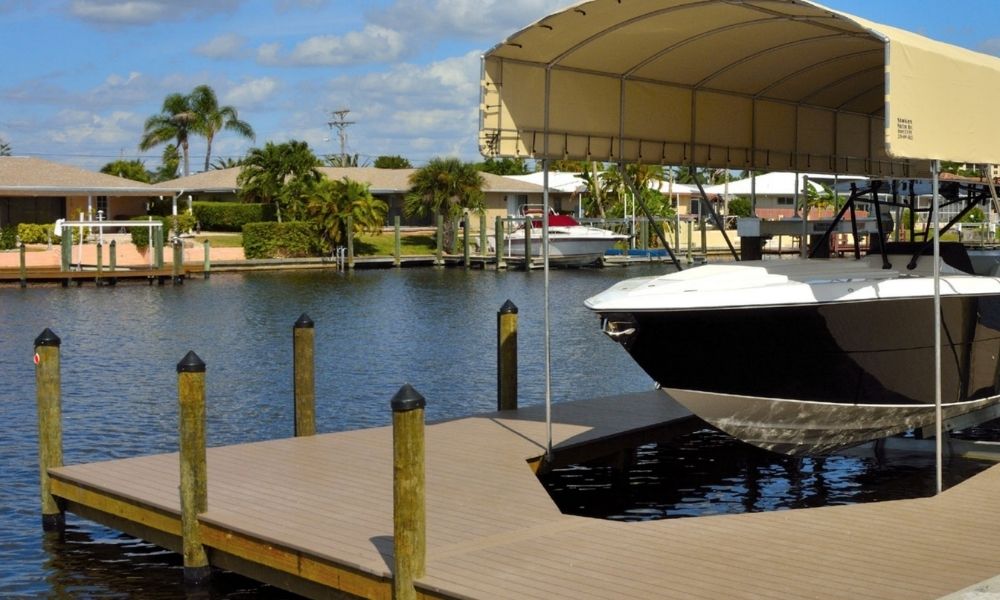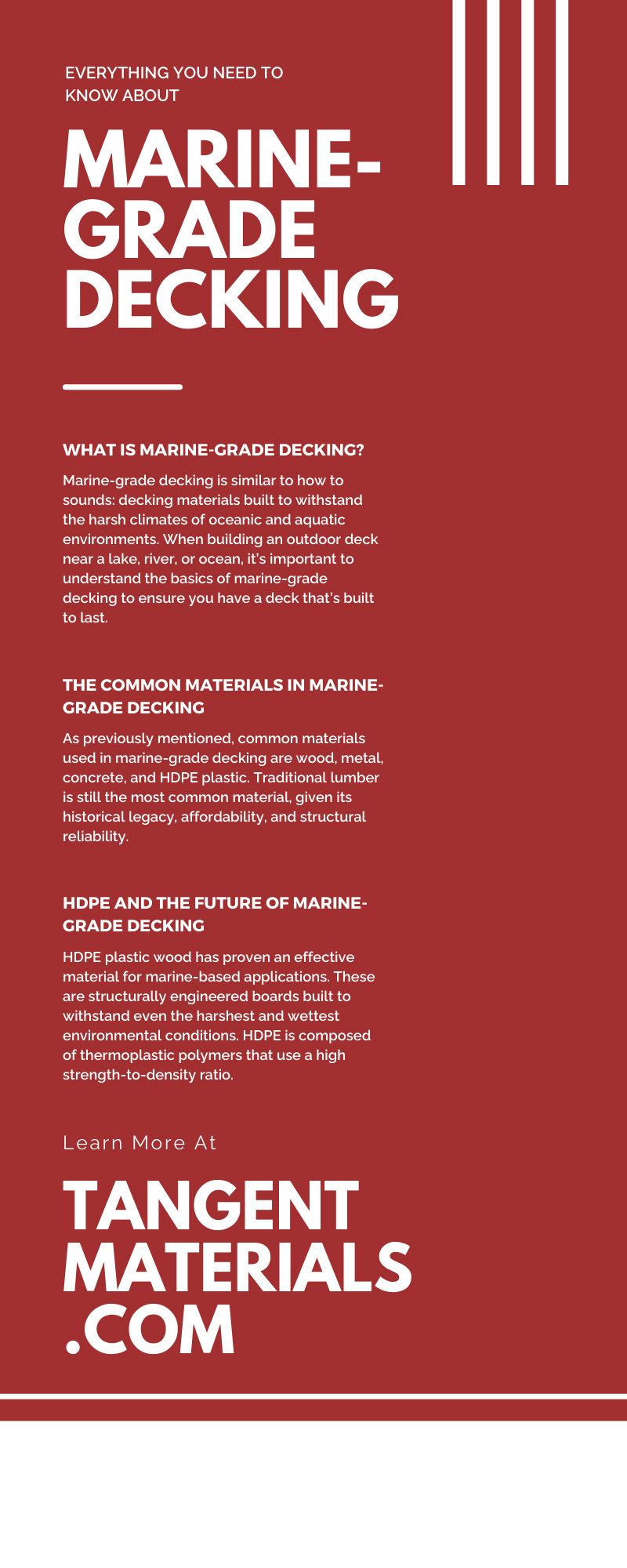Everything You Need To Know About Marine-Grade Decking

Finding the right material for marine-grade projects can be a challenge. While there are many materials to consider, use this guide to learn everything you need to know about marine-grade decking and boardwalks. You’ll see that even some of the most traditional materials don’t hold up against newer, more sustainable alternatives.
What Is Marine-Grade Decking?
Marine-grade decking is similar to how to sounds: decking materials built to withstand the harsh climates of oceanic and aquatic environments. When building an outdoor deck near a lake, river, or ocean, it’s important to understand the basics of marine-grade decking to ensure you have a deck that’s built to last. This guide helps introduce the basics of marine-grade decking for contractors and homeowners, so they know which materials to choose and which to avoid. While many opt for traditional wood, metal, or concrete, this blog also introduces the use of marine-grade high-density polyethylene (HDPE) as a viable structural material for various applications.
The Common Materials in Marine-Grade Decking
As previously mentioned, common materials used in marine-grade decking are wood, metal, concrete, and HDPE plastic. Traditional lumber is still the most common material, given its historical legacy, affordability, and structural reliability. With that, marine-grade plywood is most often used, given its durability and engineering. Douglas fir or western larch plywood sheets are light, cross-laminated, and finished with a strong adhesive that helps them withstand moisture. Marine-grade plywood is not treated with chemicals with any grades, sizes, or weights. These grades fall under A-A, A-B, B-B, High-density overlay (HDO), and medium-density overlay (MDO). A-A sheets are ½ inch thick in 4×8 or 5×12 pieces. A-B is typically stronger and heavier than A-A and comes in ¾ inch thick pieces. MDO-grade sheets use resin-impregnated thermosetting fibers under heat and pressure to provide a smooth, paintable surface. MDO and HDO grades resist chemicals, weather damage, scratching, and denting. Given these grades, marine-grade decking can also be used for boats, garden furniture, bathrooms, kitchens, porches, arbors, pergolas, and planters.
Disadvantages of Traditional Materials
Still, there are many disadvantages to traditional lumber and other materials for marine-grade applications. Despite the popularity of marine-grade plywood, it’s pricey. You pay more for installation, upkeep, and maintenance. Also, given that plywood is composed of many thin layers, it bends when overloaded. For that, marine-grade plywood requires additional support to reduce bending. Even with moisture-resistant adhesives, marine-grade plywood is not entirely waterproof. Although hardwood can withstand moisture to a certain degree, this adhesive can break down over time, leading to moisture-related issues. Wood-rot, mold, fungi, and insect infestation are still issues that can affect wood-based products like marine-grade plywood. To mitigate these issues, marine-grade plywood requires additional chemicals, which are harmful to humans and the local ecosystem.
The same issues apply to metal and concrete. Despite the common uses of stainless steel, aluminum, and copper in marine applications, metals rust when exposed to moisture. Metal also corrodes, which leads to greater structural damage and costly repairs; not to mention, it also harbors bacteria growth. With concrete, degradation applies to the wet-dry characteristics, ion type, ion concentration, temperature, and external loading. Chloride, sulfate, and carbonation further intrude on concrete stability, leading to greater breakdown and need for repairs. Temperatures, wave erosion, and salt crystallization also affect these materials.
HDPE and the Future of Marine-Grade Decking
With that in mind, it’s worth investigating the future of marine-grade decking and the use of high-density polyethylene plastics, or HDPE. HDPE plastic wood has proven an effective material for marine-based applications. These are structurally engineered boards built to withstand even the harshest and wettest environmental conditions. HDPE is composed of thermoplastic polymers that use a high strength-to-density ratio. It is often manufactured into plastic bottles, corrosive-resistant piping, and plastic lumber. There are many advantages to HDPE plastic lumber to know when used marine-based projects.
Advantages of HDPE Lumber
When learning about everything there is to know about marine-grade decking, one must understand how HDPE plastic proves better than traditional materials like wood, metal, and concrete. Plastic lumber is designed for customization, strength, and durability. Unlike traditional wood, it never rots, splinters, corrodes, or decays. When used in marine-grade applications, it repels moisture and moisture-related issues, like mold, fungi, rot, and pest infestations. Better yet, it’s sustainable. Whereas traditional wood, metal, and concrete require an intensive manufacturing process, HDPE uses post-consumer and post-industrial sources like milk jugs and plastic bottles to create a high-performing material. It requires no chemical adhesives, finishes, or protective agents either. HDPE plastic wood can also hold considerable weight without the risk of bending or warping. Its strength, durability, and resilience prove exceptional against collisions, weather, and climate. Therefore, it’s obvious that HDPE plastic wood is the future of marine-grade decking materials.
Applications of Marine-Grade HDPE Lumber
The wide versatility of marine-grade HDPE lumber makes it an exceptional structural material for various applications. While HDPE has proven more dependable than traditional wood, metal, and concrete in decking, there are other marine projects to use it for. For instance, consider HDPE bridge fenders. You need a strong, sturdy material to support your bridges, docks, and piers from accidental damage. HDPE plastic fender systems absorb impacting energy without issue. HDPE never succumbs to oceanic chemicals, warping, friction, corrosion, or other issues that other materials face. You can further use HDPE for wharves, beams, dolphins, piles, navigational aids, and piers. Many contractors and homeowners also wonder whether HDPE is optimal for substructural applications. HDPE plastic wood joists or springers provide optimal support for complete submersion without issue. Whereas constant exposure rots and damages wood and concrete, high-density polyethylene can remain submerged for prolonged periods without ever losing its quality.
For the best HDPE marine-grade decking materials, check out Tangent Solutions. We offer high-density polyethylene sheets and boards perfect for boats, barges, and any other marine application you can imagine. Our products withstand even the harshest weather conditions, so you don’t need to worry about maintenance or replacements. More so, we offer many sizes, colors, and product lines to ensure you find the right material for the job. Call now for more product information. Otherwise, order your HDPE marine-grade decking to create the perfect dock or pier of your dreams.













